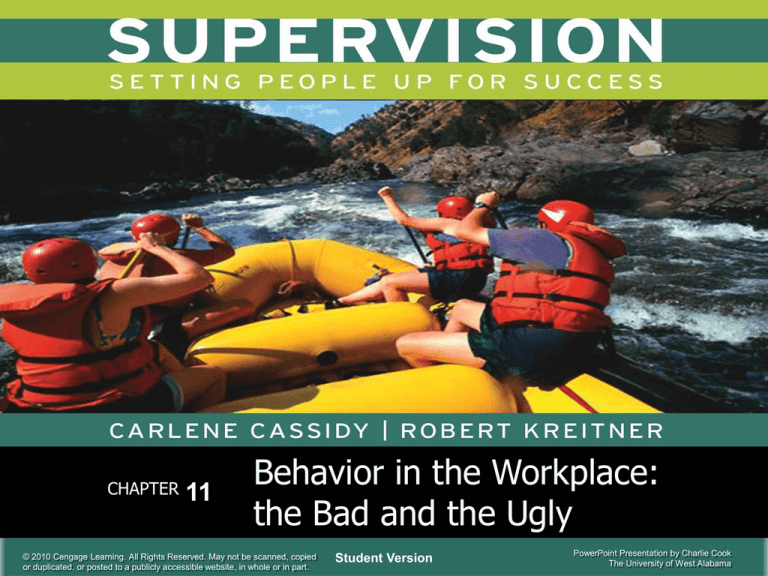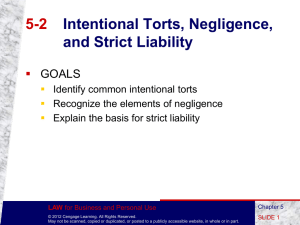
CHAPTER
11
Behavior in the Workplace:
the Bad and the Ugly
© 2010 Cengage Learning. All Rights Reserved. May not be scanned, copied
or duplicated, or posted to a publicly accessible website, in whole or in part.
Student Version
PowerPoint Presentation by Charlie Cook
The University of West Alabama
Learning Objectives
1. Identify strategies to help an underachieving
employee improve performance.
2. Explain the concept of progressive discipline.
3. Discuss how a supervisor should approach
terminating an employee.
4. Identify common sources of negative conflict at work
and describe how to manage these situations.
5. Discuss how to handle difficult situations with your
employee.
© 2010 Cengage Learning. All Rights Reserved. May not be scanned, copied
or duplicated, or posted to a publicly accessible website, in whole or in part.
11–2
Getting Underachievers on Track
Expectations
Performance Measures
Training
Addressing
Poor
Performance
Resources
© 2010 Cengage Learning. All Rights Reserved. May not be scanned, copied
or duplicated, or posted to a publicly accessible website, in whole or in part.
Obstacles
Action Plan
11–3
Expectations
• Clarifying Expectations:
Ask employee:
“Please describe for me what you think are your primary job
responsibilities and what you think is expected of you.”
If your expectations are different from those the
employee just described, then you need to review the
employee’s job description with her and reiterate your
expectations.
© 2010 Cengage Learning. All Rights Reserved. May not be scanned, copied
or duplicated, or posted to a publicly accessible website, in whole or in part.
11–4
Performance Measures
• Subjective Performance Measures
Are measures based on personal feelings and
opinions.
• Objective Performance Measures
Are measures based on quantifiable data.
© 2010 Cengage Learning. All Rights Reserved. May not be scanned, copied
or duplicated, or posted to a publicly accessible website, in whole or in part.
11–5
One of the ways that supervisors set their employees up for success
is by avoiding the use of subjective measures, clarifying expectations
and establishing mutually agreed upon performance measures that
are objective.
1. Provide two examples of subjective performance measures.
1.
2.
2. Now replace these with two examples of objective performance
measures (remember that these should be quantifiable).
1.
2.
© 2010 Cengage Learning. All Rights Reserved. May not be scanned, copied
or duplicated, or posted to a publicly accessible website, in whole or in part.
11–6
Getting Underachievers on Track
(cont’d)
• Resources
Are the items employees need to get their jobs done
successfully, such as access to information, people,
and technology.
“Do you have what you need to do your job?”
• Training
If employees receive adequate training, yet they still
are not doing satisfactory work, develop a retraining
plan anchored to specific milestones, with dates and
an outline of how training success will be determined.
© 2010 Cengage Learning. All Rights Reserved. May not be scanned, copied
or duplicated, or posted to a publicly accessible website, in whole or in part.
11–7
Getting Underachievers on Track
(cont’d)
• Action Plan
Is the road map that details the individual steps for:
What is to be done
Who is responsible
What will be measures or indicators of progress
What will be the due dates for meeting the plan’s milestones
and goals.
Should be reviewed by the supervisor with the
employee regularly.
Should be accompanied by contingency plans.
© 2010 Cengage Learning. All Rights Reserved. May not be scanned, copied
or duplicated, or posted to a publicly accessible website, in whole or in part.
11–8
Progressive (Corrective) Discipline
Counseling
Written
Warning
Suspension
Termination
for Cause
Share
Expectations
Develop
Action Plan
Day of
DecisionMaking
Return to
Work with
Action Plan
Voluntarily
Quit the Firm
© 2010 Cengage Learning. All Rights Reserved. May not be scanned, copied
or duplicated, or posted to a publicly accessible website, in whole or in part.
11–9
Brainstorm with your classmates to identify five additional items that
can be added to the lists of infractions in Figure 11.1.
1.
.
2.
3.
4.
5.
© 2010 Cengage Learning. All Rights Reserved. May not be scanned, copied
or duplicated, or posted to a publicly accessible website, in whole or in part.
11–10
Brainstorm with your classmates to identify five additional items that
can be added to the lists of infractions in Figure 11.2.
1.
.
2.
3.
4.
5.
© 2010 Cengage Learning. All Rights Reserved. May not be scanned, copied
or duplicated, or posted to a publicly accessible website, in whole or in part.
11–11
Terminating an Employee:
Policies, Procedures, and the Law
• Employment-at-Will Principle
Holds that an employer can terminate an employee at
any time without explanation or cause or that an
employee may quit at anytime without explanation or
cause.
Does not allow termination based on discrimination
against protected classes of individuals or revenge for
pursuing protected rights (e.g., whistle blowing).
© 2010 Cengage Learning. All Rights Reserved. May not be scanned, copied
or duplicated, or posted to a publicly accessible website, in whole or in part.
11–12
Negative Conflict
Poor Communication
Competition
Sources of
Negative Conflict
Personality Differences
Diverse Opinions
Real or Perceived Inequity
© 2010 Cengage Learning. All Rights Reserved. May not be scanned, copied
or duplicated, or posted to a publicly accessible website, in whole or in part.
11–13
Poor Communication
Reasons for Poor
Communications
Failing to
share
information
Making the
wrong
assumptions
© 2010 Cengage Learning. All Rights Reserved. May not be scanned, copied
or duplicated, or posted to a publicly accessible website, in whole or in part.
Failing to
trust but
validate
Failing to
listen
effectively
11–14
People in the workplace frequently make assumptions. The good
news is that many times their assumptions are correct. The bad
news is that employees also wrongly assume, which can produce
negative consequences for the organization.
1. Have you ever wrongly assumed something or been on the
opposite side of a situation where someone assumed you
knew and you did not? How did you handle it?
2. As a supervisor, what steps can you take to avoid or correct
false assumptions among your employees?
© 2010 Cengage Learning. All Rights Reserved. May not be scanned, copied
or duplicated, or posted to a publicly accessible website, in whole or in part.
11–15
Competition
Reasons for
Destructive
Competition
Competition
for
Resources
Competition
for
Rewards
© 2010 Cengage Learning. All Rights Reserved. May not be scanned, copied
or duplicated, or posted to a publicly accessible website, in whole or in part.
Competition
for
Promotion
Competition
for
Recognition
11–16
Dealing with Difficult Situations
Workplace Violence
Personal Hygiene and
Body Art
Theft
Difficult
Working
Situations
Behavior/Attitude
Substance Abuse
Verbal Abuse
Harassment
© 2010 Cengage Learning. All Rights Reserved. May not be scanned, copied
or duplicated, or posted to a publicly accessible website, in whole or in part.
11–17
Violence in the Workplace
Categories
of Threats
Direct
Threats
Conditional
Threats
Veiled
Threats
• Immediately report to management, security, and police.
• Do not confront threatening individual.
• Meet with managers to determine course of action.
© 2010 Cengage Learning. All Rights Reserved. May not be scanned, copied
or duplicated, or posted to a publicly accessible website, in whole or in part.
11–18
Theft
• Preventing Workplace Theft:
Create checks and balances by separation of duties.
Use the element of surprise to discover irregularities.
Turn on the controls already in place.
When theft does happen, take action and maintain
trust (remember “Trust but validate”).
Hire smarter and conduct background checks.
Take proactive measures with clear stated policies.
Get help from your employees to develop a culture of
honesty and intolerance for wrongdoing.
© 2010 Cengage Learning. All Rights Reserved. May not be scanned, copied
or duplicated, or posted to a publicly accessible website, in whole or in part.
11–19
Substance Abuse—Drugs in the
Workplace
• Implementing a Comprehensive Substance
Abuse Program:
Problem
assessment
Policy
development
Drug
testing
Employee
assistance
programs
© 2010 Cengage Learning. All Rights Reserved. May not be scanned, copied
or duplicated, or posted to a publicly accessible website, in whole or in part.
Employee
education
Supervisor
training
11–20
Personal hygiene problems in the workplace is an area where many
supervisors will choose to avoid the conversation because it is
awkward and/or embarrassing. Consider the scenarios below and
describe how you would handle the situation. Remember the Golden
Rule and keep in mind that different cultures have different
perspectives and traditions that may be contributing factors.
1. Body Odor. If you have an employee who has body odor or is
using heavy perfume and/or cologne that is offensive to
coworkers and customers, what would you do?
2. Appearance. If you work in a setting where personal appearance
is important and there is a dress code because employees
frequently interact with customers—such as a real estate office,
retail store or restaurant—and your employee’s clothes are
wrinkled or inappropriate, what would you do?
© 2010 Cengage Learning. All Rights Reserved. May not be scanned, copied
or duplicated, or posted to a publicly accessible website, in whole or in part.
11–21
How aware are you of signs of verbal abuse?
1. List four or five characteristics of verbal abuse.
1.
2.
3.
4.
5.
2. Reflect on a situation when you when you witnessed
these actions (if not in person, then consider a scene
from a movie). How did you feel and what was your
reaction?
© 2010 Cengage Learning. All Rights Reserved. May not be scanned, copied
or duplicated, or posted to a publicly accessible website, in whole or in part.
11–22
TERMS TO UNDERSTAND
Counseling
Employment at will
Inequity
Objective performance measures
Obstacles
Progressive discipline
Resources
Subjective performance measures
Termination
Trust but validate
Verbal abuse
Whistle blowing
© 2010 Cengage Learning. All Rights Reserved. May not be scanned, copied
or duplicated, or posted to a publicly accessible website, in whole or in part.
11–23







